Myxoma Virus Combination Therapy Enhances Lenalidomide and Bortezomib Treatments for Multiple Myeloma
Abstract
1. Introduction
2. Materials and Methods
2.1. Myxoma Virus and Cell Lines
2.2. Bone Marrow Aspiration Samples
2.3. Preparation of Primer MM Cells and Immortalization
2.4. RNA Isolation and cDNA Synthesis
2.5. Cell Viability Determination with WST-1
2.6. Apoptosis Analysis
2.6.1. Apoptosis Analysis by Flow Cytometry
2.6.2. Caspase-9 Concentration Analysis by ELISA
2.6.3. Identification of Surface Molecules That MYXV Uses for Entry into the MM Cell
2.7. Statistical Analysis
3. Results
3.1. Purification of MYXV
3.2. WST-1 Results
3.3. MYXV Induces Cell Death via Apoptosis
3.4. Analysis of Caspase-9 Expression
3.5. MYXV Entry Pathways
4. Discussion
Author Contributions
Funding
Institutional Review Board Statement
Informed Consent Statement
Data Availability Statement
Acknowledgments
Conflicts of Interest
References
- Bray, F.; Ferlay, J.; Soerjomataram, I.; Siegel, R.L.; Torre, L.A.; Jemal, A. Global cancer statistics 2018: GLOBOCAN estimates of incidence and mortality worldwide for 36 cancers in 185 countries. CA Cancer J. Clin. 2018, 68, 394–424. [Google Scholar] [CrossRef] [PubMed]
- Stewart, G.; Chantry, A.; Lawson, M. The Use of Oncolytic Viruses in the Treatment of Multiple Myeloma. Cancers 2021, 13, 5687. [Google Scholar] [CrossRef] [PubMed]
- Palumbo, A.; Avet-Loiseau, H.; Oliva, S.; Lokhorst, H.M.; Goldschmidt, H.; Rosinol, L.; Richardson, P.; Caltagirone, S.; Lahuerta, J.J.; Facon, T.; et al. Revised International Staging System for Multiple Myeloma: A Report from International Myeloma Working Group. J. Clin. Oncol. 2015, 33, 2863–2869. [Google Scholar] [CrossRef]
- Landau, D.A.; Carter, S.L.; Getz, G.; Wu, C.J. Clonal evolution in hematological malignancies and therapeutic implications. Leukemia 2014, 28, 34–43. [Google Scholar] [CrossRef] [PubMed]
- Perez Persona, E.; Mesa, M.G.; Garcia Sanchez, P.J.; Gonzalez Rodriguez, A.P. Lenalidomide treatment for patients with multiple myeloma: Diagnosis and management of most frequent adverse events. Adv. Ther. 2011, 28 (Suppl. S1), 11–16. [Google Scholar] [CrossRef]
- Laubach, J.P.; Mitsiades, C.S.; Hideshima, T.; Schlossman, R.; Chauhan, D.; Munshi, N.; Ghobrial, I.; Carreau, N.; Anderson, K.C.; Richardson, P.G. Bortezomib in the management of multiple myeloma. Cancer Manag. Res. 2009, 1, 107–117. [Google Scholar]
- Bailey, H.; Stenehjem, D.D.; Sharma, S. Panobinostat for the treatment of multiple myeloma: The evidence to date. J. Blood Med. 2015, 6, 269–276. [Google Scholar] [PubMed]
- Dima, D.; Dower, J.; Comenzo, R.L.; Varga, C. Evaluating Daratumumab in the Treatment of Multiple Myeloma: Safety, Efficacy and Place in Therapy. Cancer Manag. Res. 2020, 12, 7891–7903. [Google Scholar] [CrossRef]
- Starr, P. Elotuzumab, First-in-Class Monoclonal Antibody Immunotherapy, Improves Outcomes in Patients with Multiple Myeloma. Am. Health Drug Benefits 2015, 8, 17. [Google Scholar]
- Munshi, N.C.; Anderson, L.D., Jr.; Shah, N.; Madduri, D.; Berdeja, J.; Lonial, S.; Raje, N.; Lin, Y.; Siegel, D.; Oriol, A.; et al. Idecabtagene Vicleucel in Relapsed and Refractory Multiple Myeloma. N. Engl. J. Med. 2021, 384, 705–716. [Google Scholar] [CrossRef]
- Kelly, K.R.; Espitia, C.M.; Mahalingam, D.; Oyajobi, B.O.; Coffey, M.; Giles, F.J.; Carew, J.S.; Nawrocki, S.T. Reovirus therapy stimulates endoplasmic reticular stress, NOXA induction, and augments bortezomib-mediated apoptosis in multiple myeloma. Oncogene 2012, 31, 3023–3038. [Google Scholar] [CrossRef] [PubMed]
- Martuza, R.L.; Malick, A.; Markert, J.M.; Ruffner, K.L.; Coen, D.M. Experimental therapy of human glioma by means of a genetically engineered virus mutant. Science 1991, 252, 854–856. [Google Scholar] [CrossRef]
- Gnant, M.F.; Puhlmann, M.; Alexander, H.R., Jr.; Bartlett, D.L. Systemic administration of a recombinant vaccinia virus expressing the cytosine deaminase gene and subsequent treatment with 5-fluorocytosine leads to tumor-specific gene expression and prolongation of survival in mice. Cancer Res. 1999, 59, 3396–3403. [Google Scholar] [PubMed]
- Heise, C.; Sampson-Johannes, A.; Williams, A.; McCormick, F.; Von Hoff, D.D.; Kirn, D.H. ONYX-015, an E1B gene-attenuated adenovirus, causes tumor-specific cytolysis and antitumoral efficacy that can be augmented by standard chemotherapeutic agents. Nat. Med. 1997, 3, 639–645. [Google Scholar] [CrossRef]
- Walker, J.R.; McGeagh, K.G.; Sundaresan, P.; Jorgensen, T.J.; Rabkin, S.D.; Martuza, R.L. Local and systemic therapy of human prostate adenocarcinoma with the conditionally replicating herpes simplex virus vector G207. Hum. Gene Ther. 1999, 10, 2237–2243. [Google Scholar] [CrossRef] [PubMed]
- Bommareddy, P.K.; Shettigar, M.; Kaufman, H.L. Integrating oncolytic viruses in combination cancer immunotherapy. Nat. Rev. Immunol. 2018, 18, 498–513. [Google Scholar] [CrossRef]
- Harrington, K.; Freeman, D.J.; Kelly, B.; Harper, J.; Soria, J.C. Optimizing oncolytic virotherapy in cancer treatment. Nat. Rev. Drug Discov. 2019, 18, 689–706. [Google Scholar] [CrossRef]
- Beljanski, V.; Hiscott, J. The use of oncolytic viruses to overcome lung cancer drug resistance. Curr. Opin. Virol. 2012, 2, 629–635. [Google Scholar] [CrossRef]
- Heiber, J.F.; Xu, X.X.; Barber, G.N. Potential of vesicular stomatitis virus as an oncolytic therapy for recurrent and drug-resistant ovarian cancer. Chin. J. Cancer 2011, 30, 805–814. [Google Scholar] [CrossRef]
- Deng, H.; Tang, N.; Stief, A.E.; Mehta, N.; Baig, E.; Head, R.; Sleep, G.; Yang, X.-Z.; McKerlie, C.; Trudel, S.; et al. Oncolytic virotherapy for multiple myeloma using a tumour-specific double-deleted vaccinia virus. Leukemia 2008, 22, 2261–2264. [Google Scholar] [CrossRef]
- Naik, S.; Nace, R.; Barber, G.N.; Russell, S.J. Potent systemic therapy of multiple myeloma utilizing oncolytic vesicular stomatitis virus coding for interferon-beta. Cancer Gene Ther. 2012, 19, 443–450. [Google Scholar] [CrossRef] [PubMed]
- Reddi, H.V.; Madde, P.; McDonough, S.J.; Trujillo, M.A.; Morris, J.C., 3rd; Myers, R.M.; Peng, K.W.; Russell, S.J.; McIver, B.; Eberhardt, N.L. Preclinical efficacy of the oncolytic measles virus expressing the sodium iodide symporter in iodine non-avid anaplastic thyroid cancer: A novel therapeutic agent allowing noninvasive imaging and radioiodine therapy. Cancer Gene Ther. 2012, 19, 659–665. [Google Scholar] [CrossRef]
- Thirukkumaran, C.M.; Shi, Z.Q.; Luider, J.; Kopciuk, K.; Bahlis, N.; Neri, P.; Pho, M.; Stewart, D.; Mansoor, A.; Morris, D.G. Reovirus as a successful ex vivo purging modality for multiple myeloma. Bone Marrow Transplant. 2014, 49, 80–86. [Google Scholar] [CrossRef] [PubMed]
- Thirukkumaran, C.M.; Shi, Z.Q.; Luider, J.; Kopciuk, K.; Gao, H.; Bahlis, N.; Neri, P.; Pho, M.; Stewart, D.; Mansoor, A.; et al. Reovirus as a viable therapeutic option for the treatment of multiple myeloma. Clin. Cancer Res. 2012, 18, 4962–4972. [Google Scholar] [CrossRef] [PubMed]
- Yarde, D.N.; Nace, R.A.; Russell, S.J. Oncolytic vesicular stomatitis virus and bortezomib are antagonistic against myeloma cells in vitro but have additive anti-myeloma activity in vivo. Exp. Hematol. 2013, 41, 1038–1049. [Google Scholar] [CrossRef]
- Bartee, E.; Chan, W.M.; Moreb, J.S.; Cogle, C.R.; McFadden, G. Selective purging of human multiple myeloma cells from autologous stem cell transplantation grafts using oncolytic myxoma virus. Biol. Blood Marrow Transplant. 2012, 18, 1540–1551. [Google Scholar] [CrossRef]
- Kerr, P.J.; Best, S.M. Myxoma virus in rabbits. Rev. Sci. Technol. 1998, 17, 256–268. [Google Scholar] [CrossRef]
- Wennier, S.T.; Liu, J.; Li, S.; Rahman, M.M.; Mona, M.; McFadden, G. Myxoma virus sensitizes cancer cells to gemcitabine and is an effective oncolytic virotherapeutic in models of disseminated pancreatic cancer. Mol. Ther. 2012, 20, 759–768. [Google Scholar] [CrossRef]
- Woo, Y.; Kelly, K.J.; Stanford, M.M.; Galanis, C.; Shin Chun, Y.; Fong, Y.; McFadden, G. Myxoma virus is oncolytic for human pancreatic adenocarcinoma cells. Ann. Surg. Oncol. 2008, 15, 2329–2335. [Google Scholar] [CrossRef]
- Stanford, M.M.; Shaban, M.; Barrett, J.W.; Werden, S.J.; Gilbert, P.-A.; Bondy-Denomy, J.; MacKenzie, L.; Graham, K.C.; Chambers, A.F.; McFadden, G. Myxoma virus oncolysis of primary and metastatic B16F10 mouse tumors in vivo. Mol. Ther. 2008, 16, 52–59. [Google Scholar] [CrossRef]
- Tosic, V.; Thomas, D.L.; Kranz, D.M.; Liu, J.; McFadden, G.; Shisler, J.L.; MacNeill, A.L.; Roy, E.J. Myxoma virus expressing a fusion protein of interleukin-15 (IL15) and IL15 receptor alpha has enhanced antitumor activity. PLoS ONE 2014, 9, e109801. [Google Scholar] [CrossRef] [PubMed]
- Lun, X.; Alain, T.; Zemp, F.J.; Zhou, H.; Rahman, M.M.; Hamilton, M.G.; McFadden, G.; Bell, J.; Senger, D.L.; Forsyth, P.A. Myxoma virus virotherapy for glioma in immunocompetent animal models: Optimizing administration routes and synergy with rapamycin. Cancer Res. 2010, 70, 598–608. [Google Scholar] [CrossRef] [PubMed]
- Lun, X.; Yang, W.; Alain, T.; Shi, Z.Q.; Muzik, H.; Barrett, J.W.; McFadden, G.; Bell, J.; Hamilton, M.G.; Senger, D.L.; et al. Myxoma virus is a novel oncolytic virus with significant antitumor activity against experimental human gliomas. Cancer Res. 2005, 65, 9982–9990. [Google Scholar] [CrossRef] [PubMed]
- Kinn, V.G.; Hilgenberg, V.A.; MacNeill, A.L. Myxoma virus therapy for human embryonal rhabdomyosarcoma in a nude mouse model. Oncolytic Virother. 2016, 5, 59–71. [Google Scholar]
- Wu, Y.; Lun, X.; Zhou, H.; Wang, L.; Sun, B.; Bell, J.C.; Barrett, J.W.; McFadden, G.; Biegel, J.A.; Senger, D.L.; et al. Oncolytic efficacy of recombinant vesicular stomatitis virus and myxoma virus in experimental models of rhabdoid tumors. Clin. Cancer Res. 2008, 14, 1218–1227. [Google Scholar] [CrossRef] [PubMed]
- Bartee, M.Y.; Dunlap, K.M.; Bartee, E. Myxoma Virus Induces Ligand Independent Extrinsic Apoptosis in Human Myeloma Cells. Clin. Lymphoma Myeloma Leuk. 2016, 16, 203–212. [Google Scholar] [CrossRef]
- Lilly, C.L.; Villa, N.Y.; Lemos de Matos, A.; Ali, H.M.; Dhillon, J.S.; Hofland, T.; Rahman, M.M.; Chan, W.; Bogen, B.; Cogle, C.; et al. Ex Vivo Oncolytic Virotherapy with Myxoma Virus Arms Multiple Allogeneic Bone Marrow Transplant Leukocytes to Enhance Graft versus Tumor. Mol. Ther. Oncolytics 2017, 4, 31–40. [Google Scholar] [CrossRef]
- Kim, M.; Madlambayan, G.J.; Rahman, M.M.; Smallwood, S.E.; Meacham, A.M.; Hosaka, K.; Scott, E.W.; Cogle, C.R.; McFadden, G. Myxoma virus targets primary human leukemic stem and progenitor cells while sparing normal hematopoietic stem and progenitor cells. Leukemia 2009, 23, 2313–2317. [Google Scholar] [CrossRef]
- Byrd, D.; Amet, T.; Hu, N.; Lan, J.; Hu, S.; Yu, Q. Primary human leukocyte subsets differentially express vaccinia virus receptors enriched in lipid rafts. J. Virol. 2013, 87, 9301–9312. [Google Scholar] [CrossRef]
- Moss, B. Poxvirus cell entry: How many proteins does it take? Viruses 2012, 4, 688–707. [Google Scholar] [CrossRef]
- Hsiao, J.C.; Chung, C.S.; Chang, W. Vaccinia virus envelope D8L protein binds to cell surface chondroitin sulfate and mediates the adsorption of intracellular mature virions to cells. J. Virol. 1999, 73, 8750–8761. [Google Scholar] [CrossRef] [PubMed]
- Chiu, W.L.; Lin, C.L.; Yang, M.H.; Tzou, D.L.; Chang, W. Vaccinia virus 4c (A26L) protein on intracellular mature virus binds to the extracellular cellular matrix laminin. J. Virol. 2007, 81, 2149–2157. [Google Scholar] [CrossRef] [PubMed]
- Chung, C.S.; Hsiao, J.C.; Chang, Y.S.; Chang, W. A27L protein mediates vaccinia virus interaction with cell surface heparan sulfate. J. Virol. 1998, 72, 1577–1585. [Google Scholar] [CrossRef] [PubMed]
- Lin, C.L.; Chung, C.S.; Heine, H.G.; Chang, W. Vaccinia virus envelope H3L protein binds to cell surface heparan sulfate and is important for intracellular mature virion morphogenesis and virus infection in vitro and in vivo. J. Virol. 2000, 74, 3353–3365. [Google Scholar] [CrossRef] [PubMed]
- Izmailyan, R.; Hsao, J.C.; Chung, C.S.; Chen, C.H.; Hsu PW, C.; Liao, C.L.; Chang, W. Integrin beta1 mediates vaccinia virus entry through activation of PI3K/Akt signaling. J. Virol. 2012, 86, 6677–6687. [Google Scholar] [CrossRef] [PubMed]
- Schroeder, N.; Chung, C.S.; Chen, C.H.; Liao, C.L.; Chang, W. The lipid raft-associated protein CD98 is required for vaccinia virus endocytosis. J. Virol. 2012, 86, 4868–4882. [Google Scholar] [CrossRef] [PubMed]
- Rahman, M.M.; McFadden, G. Oncolytic Virotherapy with Myxoma Virus. J. Clin. Med. 2020, 9, 171. [Google Scholar] [CrossRef] [PubMed]
- Smallwood, S.E.; Rahman, M.M.; Smith, D.W.; McFadden, G. Myxoma virus: Propagation, purification, quantification, and storage. Curr. Protoc. Microbiol. 2010, 17, 14A-1. [Google Scholar] [CrossRef]
- Hanke, N.T.; Imler, E.; Marron, M.T.; Seligmann, B.E.; Garland, L.L.; Baker, A.F. Characterization of carfilzomib-resistant non-small cell lung cancer cell lines. J. Cancer Res. Clin. Oncol. 2018, 144, 1317–1327. [Google Scholar] [CrossRef]
- Meyerson, M.; Counter, C.M.; Eaton, E.N.; Ellisen, L.W.; Steiner, P.; Caddle, S.D.; Ziaugra, L.; Beijersbergen, R.L.; Davidoff, M.J.; Liu, Q.; et al. hEST2, the putative human telomerase catalytic subunit gene, is up-regulated in tumor cells and during immortalization. Cell 1997, 90, 785–795. [Google Scholar] [CrossRef]
- Lei, W.; Wang, S.; Xu, N.; Chen, Y.; Wu, G.; Zhang, A.; Chen, X.; Tong, Y.; Qian, W. Enhancing therapeutic efficacy of oncolytic vaccinia virus armed with Beclin-1, an autophagic Gene in leukemia and myeloma. Biomed. Pharmacother. 2020, 125, 110030. [Google Scholar] [CrossRef]
- Packiriswamy, N.; Upreti, D.; Zhou, Y.; Khan, R.; Miller, A.; Diaz, R.M.; Rooney, C.M.; Dispenzieri, A.; Peng, K.-W.; Russell, S.J. Oncolytic measles virus therapy enhances tumor antigen-specific T-cell responses in patients with multiple myeloma. Leukemia 2020, 34, 3310–3322. [Google Scholar] [CrossRef] [PubMed]
- Thirukkumaran, C.M.; Shi, Z.Q.; Nuovo, G.J.; Luider, J.; Kopciuk, K.A.; Dong, Y.; Mostafa, A.A.; Thakur, S.; Gratton, K.; Yang, A.; et al. Oncolytic immunotherapy and bortezomib synergy improves survival of refractory multiple myeloma in a preclinical model. Blood Adv. 2019, 3, 797–812. [Google Scholar] [CrossRef]
- Villa, N.Y.; Rahman, M.M.; Mamola, J.; Sharik, M.E.; de Matos, A.L.; Kilbourne, J.; Lowe, K.; Daggett-Vondras, J.; D’Isabella, J.; Goras, E.; et al. Transplantation of autologous bone marrow pre-loaded ex vivo with oncolytic myxoma virus is efficacious against drug-resistant Vk*MYC mouse myeloma. Oncotarget 2022, 13, 490–504. [Google Scholar] [CrossRef] [PubMed]
- Fernandes, M.S.; Gomes, E.M.; Butcher, L.D.; Hernandez-Alcoceba, R.; Chang, D.; Kansopon, J.; Newman, J.; Stone, M.J.; Tong, A.W. Growth inhibition of human multiple myeloma cells by an oncolytic adenovirus carrying the CD40 ligand transgene. Clin. Cancer Res. 2009, 15, 4847–4856. [Google Scholar] [CrossRef] [PubMed]
- Senac, J.S.; Doronin, K.; Russell, S.J.; Jelinek, D.F.; Greipp, P.R.; Barry, M.A. Infection and killing of multiple myeloma by adenoviruses. Hum. Gene Ther. 2010, 21, 179–190. [Google Scholar] [CrossRef]
- Ghose, J.; Dona, A.; Murtadha, M.; Gunes, E.G.; Caserta, E.; Yoo, J.Y.; Russell, L.; Jaime-Ramirez, A.C.; Barwick, B.G.; Gupta, V.A.; et al. Oncolytic herpes simplex virus infects myeloma cells in vitro and in vivo. Mol. Ther. Oncolytics 2021, 20, 519–531. [Google Scholar] [CrossRef]
- Oku, M.; Ishino, R.; Uchida, S.; Imataki, O.; Sugimoto, N.; Todo, T.; Kadowaki, N. Oncolytic herpes simplex virus type 1 (HSV-1) in combination with lenalidomide for plasma cell neoplasms. Br. J. Haematol. 2021, 192, 343–353. [Google Scholar] [CrossRef]
- Thirukkumaran, C.M.; Shi, Z.Q.; Luider, J.; Kopciuk, K.; Gao, H.; Bahlis, N.; Neri, P.; Pho, M.; Stewart, D.; Mansoor, A.; et al. Reovirus modulates autophagy during oncolysis of multiple myeloma. Autophagy 2013, 9, 413–414. [Google Scholar] [CrossRef]
- Calton, C.M.; Kelly, K.R.; Anwer, F.; Carew, J.S.; Nawrocki, S.T. Oncolytic Viruses for Multiple Myeloma Therapy. Cancers 2018, 10, 198. [Google Scholar] [CrossRef]
- Zhang, Q.S.; Zhang, M.; Huang, X.J.; Liu, X.J.; Li, W.P. Apoptosis-inducing effect of myxoma virus on human neuroglioma cell lines. Exp. Ther. Med. 2017, 14, 344–348. [Google Scholar] [CrossRef] [PubMed][Green Version]
- Pisklakova, A.; McKenzie, B.; Zemp, F.; Lun, X.; Kenchappa, R.S.; Etame, A.B.; Rahman, M.M.; Reilly, K.; Pilon-Thomas, S.; McFadden, G.; et al. M011L-deficient oncolytic myxoma virus induces apoptosis in brain tumor-initiating cells and enhances survival in a novel immunocompetent mouse model of glioblastoma. Neuro Oncol. 2016, 18, 1088–1098. [Google Scholar] [CrossRef] [PubMed]
- Madlambayan, G.J.; Bartee, E.; Kim, M.; Rahman, M.M.; Meacham, A.; Scott, E.W.; McFadden, G.; Cogle, C.R. Acute myeloid leukemia targeting by myxoma virus in vivo depends on cell binding but not permissiveness to infection in vitro. Leuk. Res. 2012, 36, 619–624. [Google Scholar] [CrossRef] [PubMed]
- Villa, N.Y.; Wasserfall, C.H.; Meacham, A.M.; Wise, E.; Chan, W.; Wingard, J.R.; McFadden, G.; Cogle, C.R. Myxoma virus suppresses proliferation of activated T lymphocytes yet permits oncolytic virus transfer to cancer cells. Blood 2015, 125, 3778–3788. [Google Scholar] [CrossRef] [PubMed]
- Bartee, E.; Bartee, M.Y.; Bogen, B.; Yu, X.Z. Systemic therapy with oncolytic myxoma virus cures established residual multiple myeloma in mice. Mol. Ther. Oncolytics 2016, 3, 16032. [Google Scholar] [CrossRef]
- Villa, N.Y.; Rahman, M.M.; Mamola, J.; D’Isabella, J.; Goras, E.; Kilbourne, J.; Lowe, K.; Daggett-Vondras, J.; Torres, L.; Christie, J.; et al. Autologous Transplantation Using Donor Leukocytes Loaded Ex Vivo with Oncolytic Myxoma Virus Can Eliminate Residual Multiple Myeloma. Mol. Ther. Oncolytics 2020, 18, 171–188. [Google Scholar] [CrossRef]
- Stiff, A.; Caserta, E.; Sborov, D.W.; Nuovo, G.J.; Mo, X.; Schlotter, S.Y.; Canella, A.; Smith, E.; Badway, J.; Old, M.; et al. Histone Deacetylase Inhibitors Enhance the Therapeutic Potential of Reovirus in Multiple Myeloma. Mol. Cancer Ther. 2016, 15, 830–841. [Google Scholar] [CrossRef]
- Dunlap, K.M.; Bartee, M.Y.; Bartee, E. Myxoma virus attenuates expression of activating transcription factor 4 (ATF4) which has implications for the treatment of proteasome inhibitor-resistant multiple myeloma. Oncolytic Virother. 2015, 4, 1–11. [Google Scholar]
- Moser-Katz, T.; Joseph, N.S.; Dhodapkar, M.V.; Lee, K.P.; Boise, L.H. Game of Bones: How Myeloma Manipulates Its Microenvironment. Front. Oncol. 2020, 10, 625199. [Google Scholar] [CrossRef]
- Zheng, Y.; Cai, Z.; Wang, S.; Zhang, X.; Qian, J.; Hong, S.; Li, H.; Wang, M.; Yang, J.; Yi, Q. Macrophages are an abundant component of myeloma microenvironment and protect myeloma cells from chemotherapy drug-induced apoptosis. Blood 2009, 114, 3625–3628. [Google Scholar] [CrossRef]
- Bahlis, N.J.; King, A.M.; Kolonias, D.; Carlson, L.M.; Liu, H.Y.; Hussein, M.A.; Terebelo, H.R.; Byrne, G.E.; Levine, B.L.; Boise, L.H.; et al. CD28-mediated regulation of multiple myeloma cell proliferation and survival. Blood 2007, 109, 5002–5010. [Google Scholar] [CrossRef] [PubMed]
- Jaiswal, S.R.; Bhakuni, P.; Bansal, S.; Aiyer, H.M.; Bhargava, S.; Chakrabarti, S. Targeting CD28-CD86 Pathway for Refractory Myeloma Through CTLA4Ig-Based Reduced-Intensity Conditioning and Donor Lymphocyte Infusions After Haploidentical Transplantation. Clin. Lymphoma Myeloma Leuk. 2019, 19, e430–e435. [Google Scholar] [CrossRef] [PubMed]
- Gavile, C.M.; Barwick, B.G.; Newman, S.; Neri, P.; Nooka, A.K.; Lonial, S.; Lee, K.P.; Boise, L.H. CD86 regulates myeloma cell survival. Blood Adv. 2017, 1, 2307–2319. [Google Scholar] [CrossRef] [PubMed]
- Moser-Katz, T.; Gavile, C.M.; Barwick, B.G.; Lee, K.P.; Boise, L.H. PDZ Proteins SCRIB and DLG1 Regulate Myeloma Cell Surface CD86 Expression, Growth, and Survival. Mol. Cancer Res. 2022, 20, 1122–1136. [Google Scholar] [CrossRef]
- Moreaux, J.; Hose, D.; Reme, T.; Jourdan, E.; Hundemer, M.; Legouffe, E.; Moine, P.; Bourin, P.; Moos, M.; Corre, J.; et al. CD200 is a new prognostic factor in multiple myeloma. Blood 2006, 108, 4194–4197. [Google Scholar] [CrossRef]
- Shi, Q.; Wu, C.; Han, W.; Zhao, S.; Wu, Y.; Jin, Y.; Qu, X.; Li, J.; Zhang, R.; Chen, L. Clinical significance of CD200 expression in newly diagnosed multiple myeloma patients and dynamic changing during treatment. Leuk. Lymphoma 2021, 62, 709–715. [Google Scholar] [CrossRef]
- Yang, C.; Hua, N.; Xie, S.; Wu, Y.; Zhu, L.; Wang, S.; Tong, X. Oncolytic viruses as a promising therapeutic strategy for hematological malignancies. Biomed. Pharmacother. 2021, 139, 111573. [Google Scholar] [CrossRef]
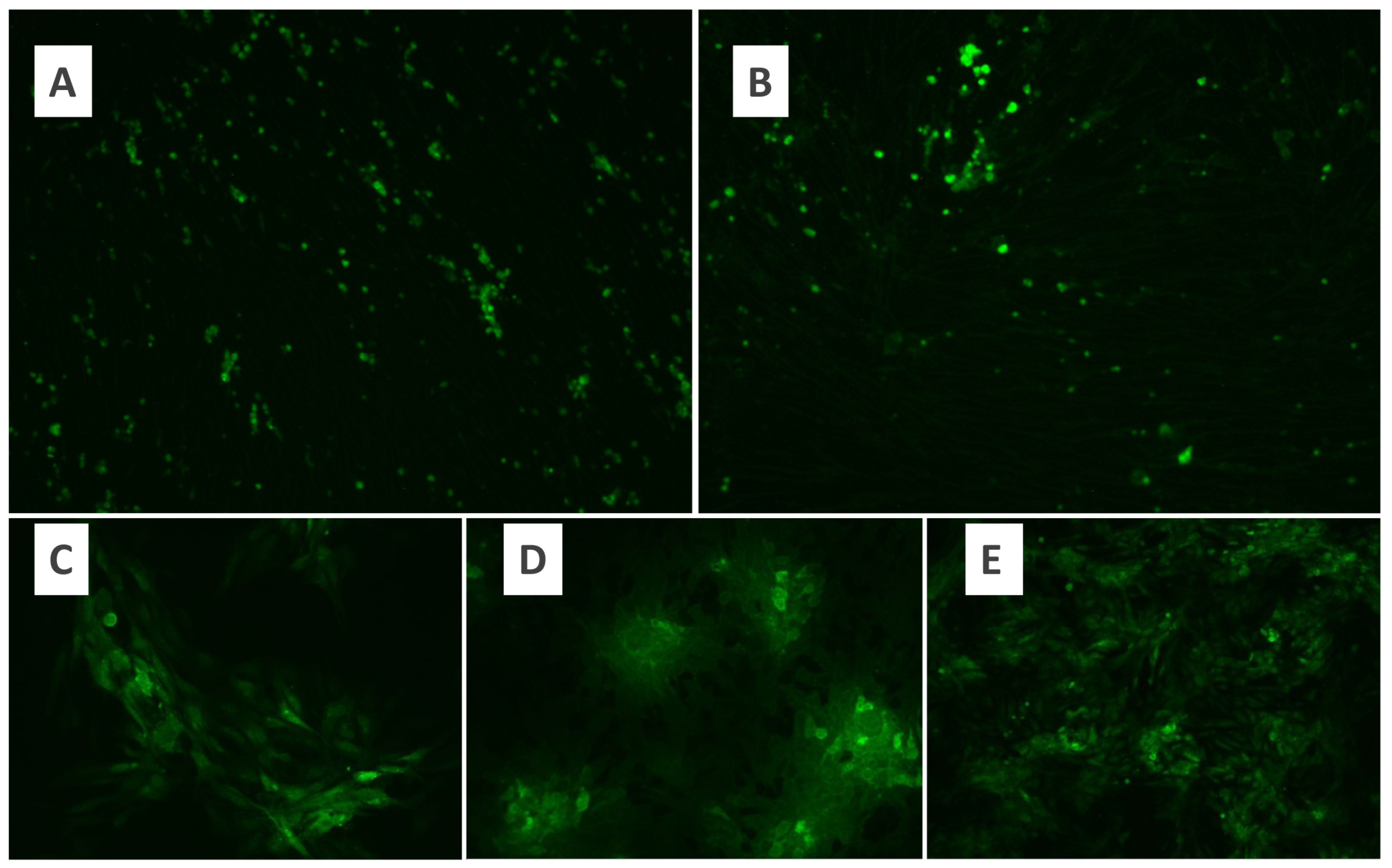
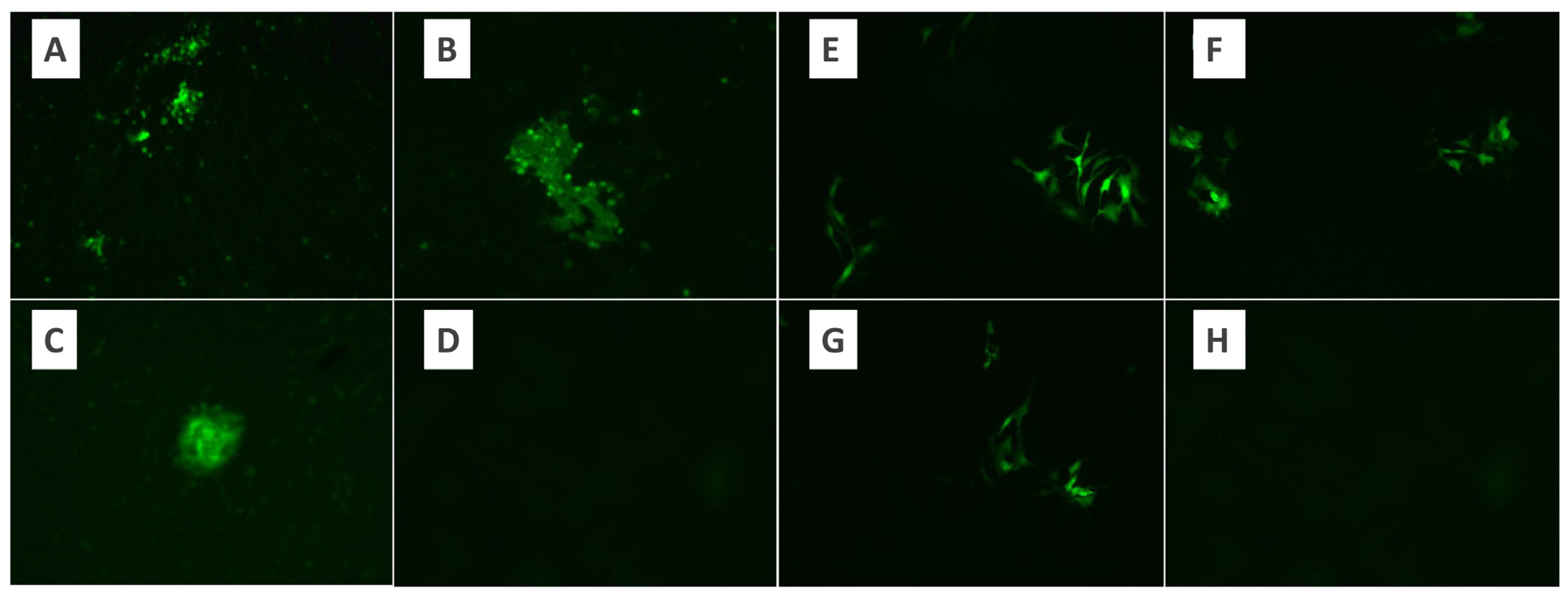
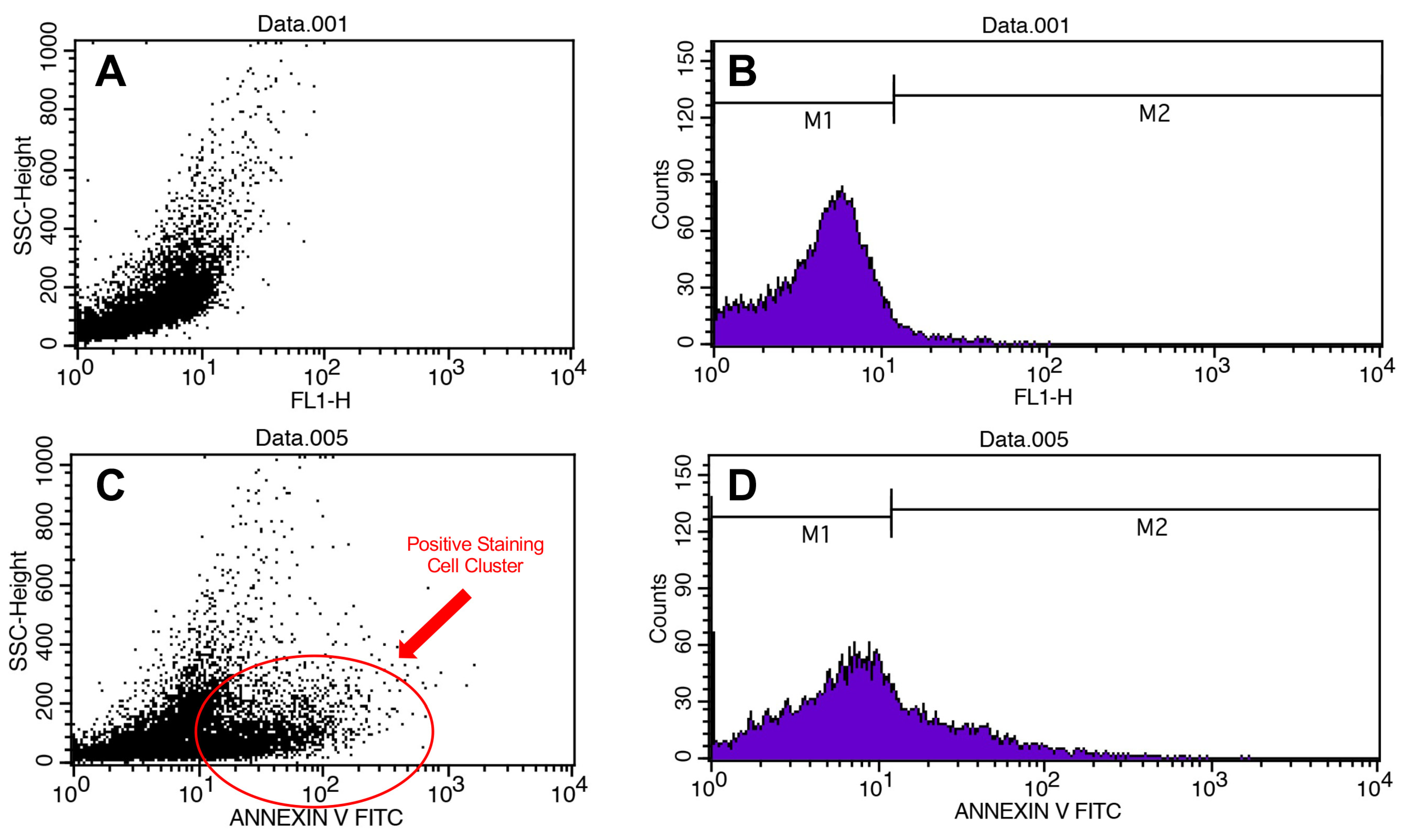
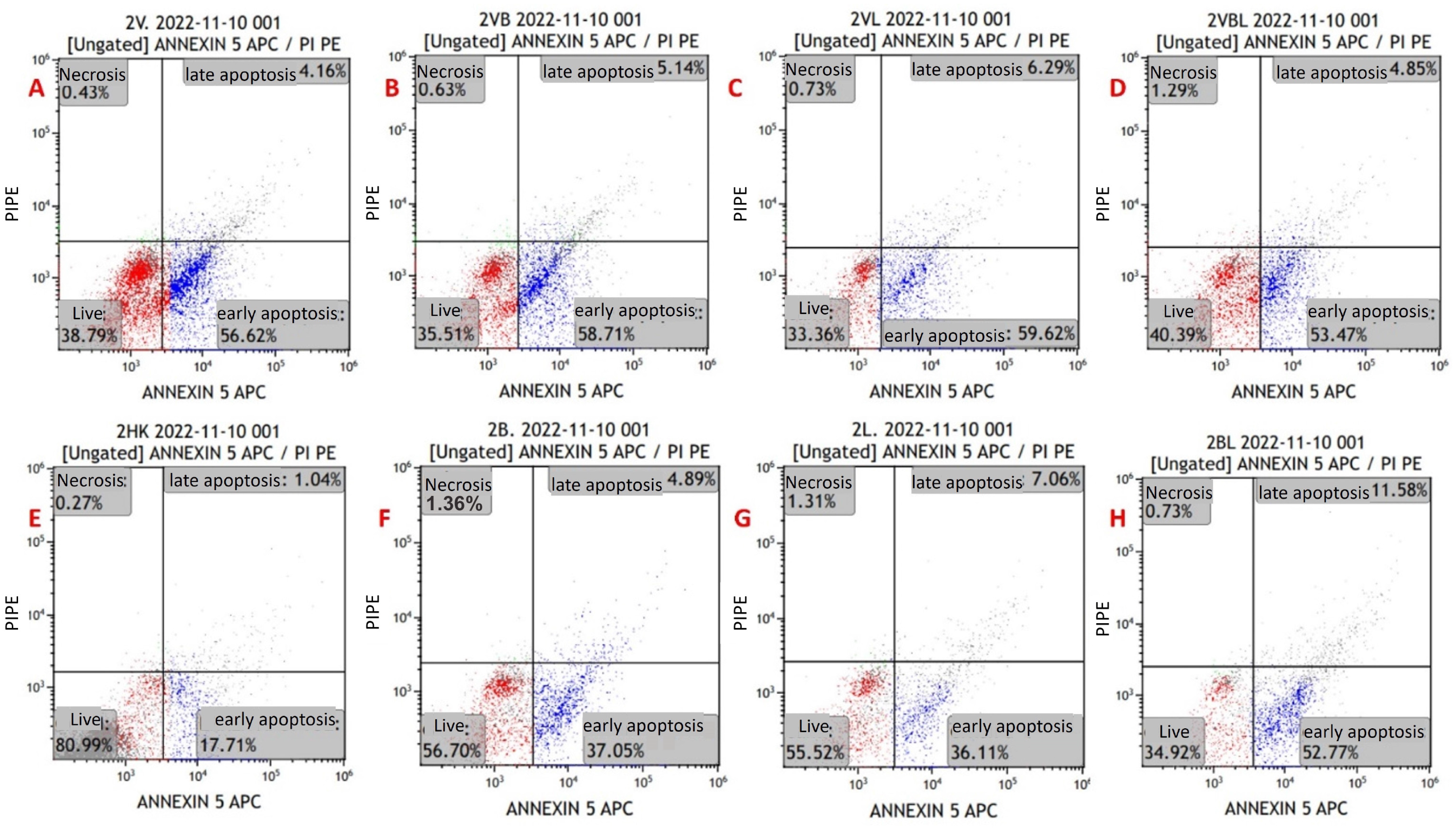
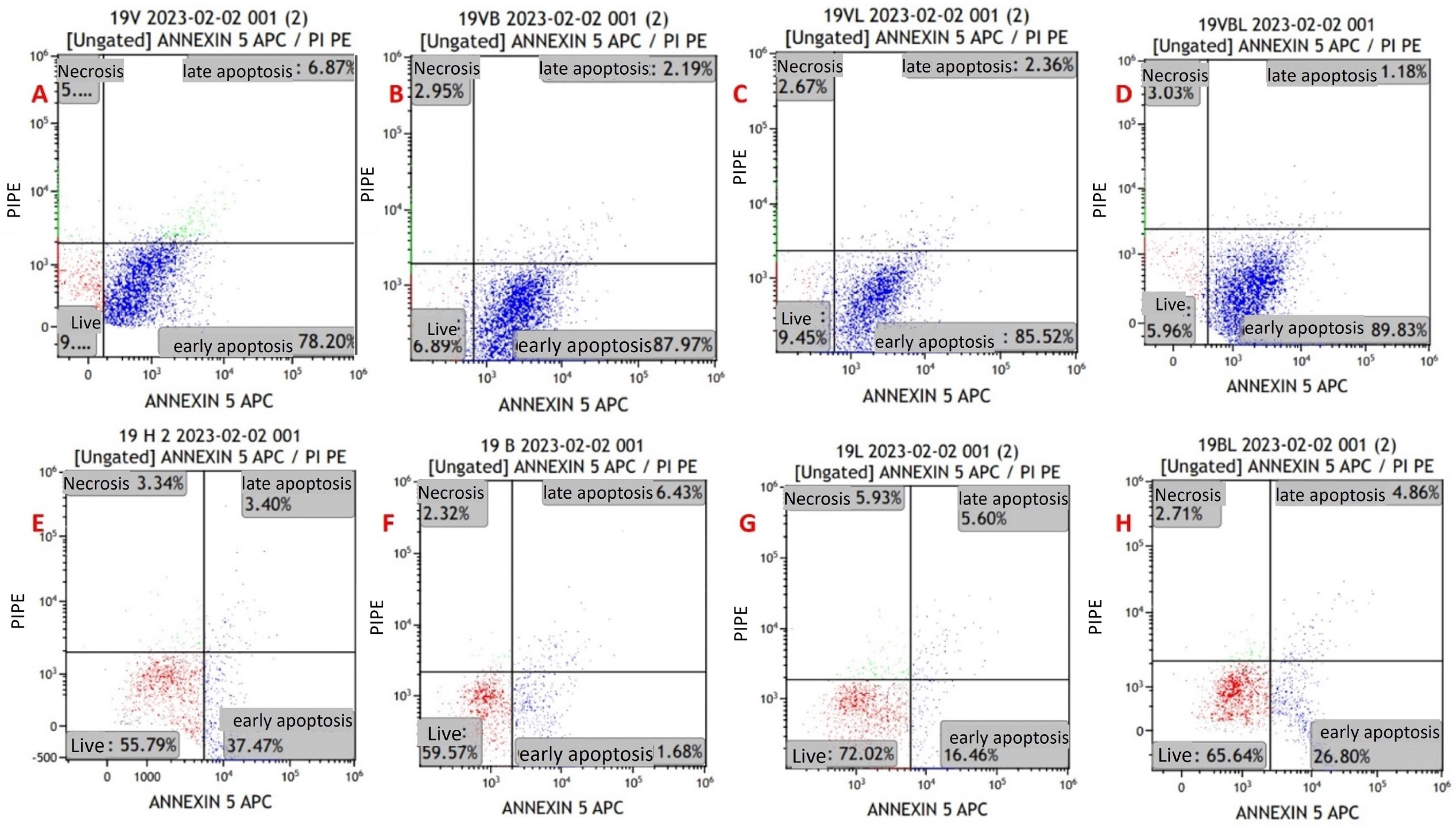
| Biolegend Catalog No. | Antibody | Determined “Middle” Concentration |
|---|---|---|
| 302902 | Purified anti-human CD28 | 0.5 µg/100 µL |
| 302302 | Purified anti-human CD20 | 2 µg/100 µL |
| 356602 | Purified anti-human CD38 | 0.5 µg/100 µL |
| 323404 | Purified anti-human CD117 | 0.5 µg/100 µL |
| 303402 | Purified anti-human CD33 | 0.5 µg/100 µL |
| 362502 | Purified anti-human CD56 | 4 µg/100 µL |
| 329202 | Purified anti-human CD200 | 2 µg/100 µL |
| 374202 | Purified anti-human CD86 | 0.5 µg/100 µL |
| 357502 | Purified anti-human CD269 | 4 µg/100 µL |
| 356502 | Purified anti-human CD138 | 0.5 µg/100 µL |
| 340202 | Purified anti-human CD307 | 0.5 µg/100 µL |
| MM Patient | Groups | Mean ± S.D. | p-Value |
|---|---|---|---|
| Newly Diagnosed | MYXV | 137.29 ± 40.45 | 0.001 |
| MYXV + Bortezomib | 141.37 ± 49.17 | 0.001 | |
| MYXV + Lenalidomide | 139.81 ± 43.53 | 0.001 | |
| MYXV + Bortezomib + Lenalidomide | 152.56 ± 60.79 | 0.001 | |
| Bortezomib | 93.28 ± 8.85 | 0.001 | |
| Lenalidomide | 100.45 ± 11.33 | 0.735 | |
| Bortezomib + Lenalidomide | 96.03 ± 12.54 | 0.197 | |
| Refractory | MYXV | 125.78 ± 17.81 | 0.000 |
| MYXV + Bortezomib | 126.76 ± 22.74 | 0.001 | |
| MYXV + Lenalidomide | 129.81 ± 43.53 | 0.001 | |
| MYXV + Bortezomib + Lenalidomide | 126.57 ± 23.32 | 0.001 | |
| Bortezomib | 91.49 ± 8.28 | 0.001 | |
| Lenalidomide | 94.04 ± 8.24 | 0.006 | |
| Bortezomib + Lenalidomide | 90.43 ± 10.46 | 0.000 |
| Groups | Viability | Early Apoptosis | Late Apoptosis | Necrosis | ||||
|---|---|---|---|---|---|---|---|---|
| p-Value | p-Value | p-Value | p-Value | |||||
| Control | 69.23 ± 19.11 | <0.001 | 17.13 ± 13.12 | <0.001 | 5.85 ± 7.23 | p > 0.05 | 7.76 ± 11.04 | p > 0.05 |
| Bortezomib | 65.00 ± 23.51 | 24.82 ± 18.86 | 6.02 ± 6.74 | 4.16 ± 4.51 | ||||
| Lenalidomide | 69.54 ± 21.65 | 19.97 ± 16.46 | 5.23 ± 5.74 | 5.24 ± 5.35 | ||||
| Bortezomib + Lenalidomide | 66.18 ± 27.34 | 21.58 ± 19.93 | 6 ± 6.46 | 6.22 ± 13.21 | ||||
| MYXV | 41.76 ± 29.47 1b. 5c. 9b. 13b | 45.89 ± 27.09 1a. 5b. 9a. 13b | 5.98 ± 6.99 | 6.26 ± 10.06 | ||||
| MYXV + Bortezomib | 40.51 ± 27.55 2b. 6b. 10a. 14b | 45.42 ± 26.07 2a. 6b. 10a. 14b | 6.94 ± 8.16 | 7.12 ± 11.97 | ||||
| MYXV + Lenalidomide | 38.71 ± 26.85 3b. 7c. 11b. 15c | 44.32 ± 25.85 3a. 7c. 11b. 15b | 4.98 ± 5.46 | 7.74 ± 14.44 | ||||
| MYXV + Bortezomib + Lenalidomide | 54.23 ± 28.54 4a. 8b. 12a. 16b | 47.12 ± 25.08 4a. 8b. 12a. 16a | 6.78 ± 8.39 | 7.41 ± 11.03 | ||||
| Groups | Viability | Early Apoptosis | Late Apoptosis | Necrosis | ||||
|---|---|---|---|---|---|---|---|---|
| p-Value | p-Value | p-Value | p-Value | |||||
| Control | 78.00 ± 17.88 | <0.001 | 17.43 ± 14.05 | <0.001 | 2.24 ± 4.35 | p > 0.05 | 2.31 ± 2.22 | p > 0.05 |
| Bortezomib | 65.73 ± 19.49 | 18.75 ± 17.86 | 2.51 ± 4.18 | 3.05 ± 4.84 | ||||
| Lenalidomide | 78.21 ± 19.27 | 16.57 ± 16.45 | 2.47 ± 4.16 | 2.73 ± 3.22 | ||||
| Bortezomib + Lenalidomide | 78.94 ± 20.45 | 16.13 ± 16.9 | 2.58 ± 4.32 | 2.33 ± 2.78 | ||||
| MYXV | 52.67 ± 27.22 1c. 9c. 13c | 41.18 ± 24.19 1c. 5c. 9c. 13b | 3.03 ± 5.2 | 3.2 ± 4.91 | ||||
| MYXV + Bortezomib | 50.48 ± 24.71 2c. 6c. 10c. 14c | 42.42 ± 21.89 2b. 6c. 10b. 14b | 3.32 ± 6.02 | 3.77 ± 6.56 | ||||
| MYXV + Lenalidomide | 51.24 ± 23.29 3c. 7c. 11c. 15c | 43.04 ± 20.59 3b. 7c. 11b. 15b | 2.13 ± 3.88 | 3.57 ± 6.09 | ||||
| MYXV + Bortezomib + Lenalidomide | 50.8 ± 24.61 4c. 8c. 12c. 16c | 40.96 ± 20.08 4c. 8c. 12c. 16b | 4.06 ± 8.34 | 4.2 ± 6.8 | ||||
| Groups | Viability | Early Apoptosis | Late Apoptosis | Necrosis | ||||
|---|---|---|---|---|---|---|---|---|
| p-Value | p-Value | p-Value | p-Value | |||||
| Control | 59.21 ± 15.6 | <0.001 | 16.79 ± 12.49 | <0.001 | 9.97 ± 7.79 | p > 0.05 | 13.99 ± 13.71 | p > 0.05 |
| Bortezomib | 52.74 ± 22.15 | 31.77 ± 18.1 | 10.04 ± 6.98 | 5.43 ± 3.89 | ||||
| Lenalidomide | 59.63 ± 20.48 | 23.86 ± 16.18 | 8.37 ± 5.79 | 8.12 ± 5.93 | ||||
| Bortezomib + Lenalidomide | 51.60 ± 27.49 | 27.81 ± 21.86 | 9.9 ± 6.38 | 10.67 ± 18.46 | ||||
| MYXV | 29.28 ± 27.73 1c. 5c | 51.27 ± 30.06 1b | 9.35 ± 7.4 | 9.86 ± 13.11 | ||||
| MYXV + Bortezomib | 29.11 ± 29.94 2c. 6c | 48.85 ± 30.65 2c | 11.08 ± 8.5 | 10.95 ± 15.51 | ||||
| MYXV + Lenalidomide | 33.45 ± 28.3 8c | 45.78 ± 31.58 3c | 8.25 ± 5.27 | 12.51 ± 19.4 | ||||
| MYXV + Bortezomib + Lenalidomide | 24.90 ± 27.07 4b. 7b | 54.16 ± 28.95 4b. 7c | 9.88 ± 7.58 | 11.05 ± 13.83 | ||||
| Multiple Myeloma | Mean ± S.D. | p | |
|---|---|---|---|
| Control | Newly Diagnosed | 2.90 ± 0.55 | 0.299 |
| Refractory | 2.34 ± 0.29 | ||
| Bortezomib | Newly Diagnosed | 2.76 ± 0.28 | 0.803 |
| Refractory | 2.79 ± 0.41 | ||
| Lenalidomide | Newly Diagnosed | 2.32 ± 0.26 | 0.852 |
| Refractory | 2.44 ± 0.36 | ||
| Bortezomib + Lenalidomide | Newly Diagnosed | 2.30 ± 0.27 | 0.349 |
| Refractory | 2.16 ± 0.39 | ||
| MYXV | Newly Diagnosed | 5.42 ± 0.62 | 0.135 |
| Refractory | 5.86 ± 1.81 | ||
| MYXV + Bortezomib | Newly Diagnosed | 6.55 ± 1.00 | 0.081 |
| Refractory | 5.95 ± 2.06 | ||
| MYXV + Lenalidomide | Newly Diagnosed | 5.84 ± 0.86 | 0.383 |
| Refractory | 6.73 ± 2.41 | ||
| MYXV + Bortezomib + Lenalidomide | Newly Diagnosed | 6.95 ± 0.85 | 0.158 |
| Refractory | 7.85 ± 2.99 |
| Newly Diagnosed MM | Refractory MM | |||
|---|---|---|---|---|
| Mean ± S.D. | p | Mean ± S.D. | p | |
| Control | 2.90 ± 0.55 | 0.001 | 2.34 ± 0.29 | 0.001 |
| MYXV | 5.27 ± 0.62 | 5.86 ± 1.81 | ||
| Bortezomib | 2.76 ± 0.28 | <0.001 | 2.79 ± 0.41 | 0.013 |
| MYXV+ Bortezomib | 6.56 ± 1.00 | 5.95 ± 2.06 | ||
| Lenalidomide | 2.32 ± 0.26 | <0.001 | 2.44 ± 0.36 | 0.001 |
| MYXV + Lenalidomide | 5.64 ± 0.86 | 6.73 ± 2.41 | ||
| Bortezomib + Lenalidomide | 2.30 ± 0.27 | <0.001 | 2.16 ± 0.39 | <0.001 |
| MYXV + Bortezomib + Lenalidomide | 6.91 ± 0.85 | 7.85 ± 2.99 | ||
| Refractory Patient 1 | Refractory Patient 2 | Newly Diagnosed Patient 2 | Newly Diagnosed Patient 2 | |
|---|---|---|---|---|
| CD33_Low | 0.120 | 0.619 | 0.029 | 0.000 |
| CD33_Middle | 0.202 | 0.058 | 0.084 | 0.016 |
| CD33_High | 0.011 | 0.352 | 0.020 | 0.009 |
| CD86_Low | 0.001 | 0.134 | 0.012 | 0.014 |
| CD86_Middle | 0.002 | 0.153 | 0.046 | 0.004 |
| CD86_High | 0.002 | 0.217 | 0.040 | 0.005 |
| CD20_Low | 0.004 | 0.551 | 0.083 | 0.296 |
| CD20_Middle | 0.001 | 0.002 | 0.313 | 0.086 |
| CD20_High | 0.037 | 0.030 | 0.052 | 0.095 |
| CD200_Low | 0.001 | 0.001 | 0.079 | 0.091 |
| CD200_Middle | 0.003 | 0.016 | 0.185 | 0.150 |
| CD200_High | 0.017 | 0.006 | 0.242 | 0.270 |
| CD56_Low | 0.063 | 0.154 | 0.158 | 0.454 |
| CD56_Middle | 0.002 | 0.004 | 0.011 | 0.222 |
| CD56_High | 0.028 | 0.064 | 0.003 | 0.054 |
| BCMA_Low | 0.233 | 0.390 | 0.091 | 0.169 |
| BCMA_Middle | 0.003 | 0.016 | 0.028 | 0.333 |
| BCMA_High | 0.002 | 0.007 | 0.048 | 0.546 |
| CD28_Low | 0.349 | 0.002 | 0.046 | 0.236 |
| CD28_Middle | 0.014 | 0.008 | 0.038 | 0.066 |
| CD28_High | 0.009 | 0.026 | 0.576 | 0.017 |
| CD38_Low | 0.668 | 0.056 | 0.011 | 0.344 |
| CD38_Middle | 0.004 | 0.023 | 0.014 | 0.033 |
| CD38_High | 0.119 | 0.022 | 0.003 | 0.725 |
| CD117_Low | 0.032 | 0.277 | 0.011 | 0.042 |
| CD117_Middle | 0.022 | 0.015 | 0.014 | 0.135 |
| CD117_High | 0.045 | 0.013 | 0.020 | 0.070 |
| CD138_Low | 0.022 | 0.468 | 0.006 | 0.200 |
| CD138_Middle | 0.004 | 0.005 | 0.009 | 0.210 |
| CD138_High | 0.004 | 0.021 | 0.004 | 0.373 |
| CD307_Low | 0.014 | 0.022 | 0.009 | 0.078 |
| CD307_Middle | 0.002 | 0.530 | 0.003 | 0.075 |
| CD307_High | 0.009 | 0.083 | 0.018 | 0.076 |
Disclaimer/Publisher’s Note: The statements, opinions and data contained in all publications are solely those of the individual author(s) and contributor(s) and not of MDPI and/or the editor(s). MDPI and/or the editor(s) disclaim responsibility for any injury to people or property resulting from any ideas, methods, instructions or products referred to in the content. |
© 2024 by the authors. Licensee MDPI, Basel, Switzerland. This article is an open access article distributed under the terms and conditions of the Creative Commons Attribution (CC BY) license (https://creativecommons.org/licenses/by/4.0/).
Share and Cite
Yeşilaltay, A.; Muz, D.; Erdal, B.; Bilgen, T.; Batar, B.; Turgut, B.; Topçu, B.; Yılmaz, B.; Avcı, B.A. Myxoma Virus Combination Therapy Enhances Lenalidomide and Bortezomib Treatments for Multiple Myeloma. Pathogens 2024, 13, 72. https://doi.org/10.3390/pathogens13010072
Yeşilaltay A, Muz D, Erdal B, Bilgen T, Batar B, Turgut B, Topçu B, Yılmaz B, Avcı BA. Myxoma Virus Combination Therapy Enhances Lenalidomide and Bortezomib Treatments for Multiple Myeloma. Pathogens. 2024; 13(1):72. https://doi.org/10.3390/pathogens13010072
Chicago/Turabian StyleYeşilaltay, Alpay, Dilek Muz, Berna Erdal, Türker Bilgen, Bahadır Batar, Burhan Turgut, Birol Topçu, Bahar Yılmaz, and Burcu Altındağ Avcı. 2024. "Myxoma Virus Combination Therapy Enhances Lenalidomide and Bortezomib Treatments for Multiple Myeloma" Pathogens 13, no. 1: 72. https://doi.org/10.3390/pathogens13010072
APA StyleYeşilaltay, A., Muz, D., Erdal, B., Bilgen, T., Batar, B., Turgut, B., Topçu, B., Yılmaz, B., & Avcı, B. A. (2024). Myxoma Virus Combination Therapy Enhances Lenalidomide and Bortezomib Treatments for Multiple Myeloma. Pathogens, 13(1), 72. https://doi.org/10.3390/pathogens13010072





